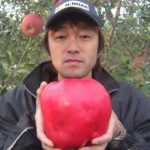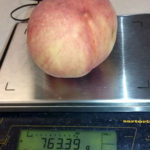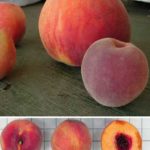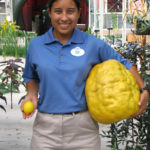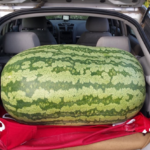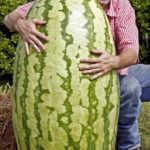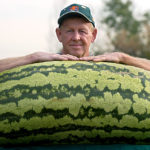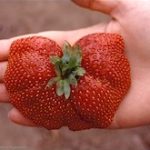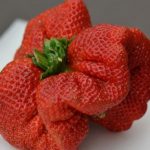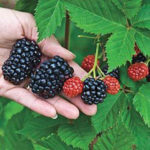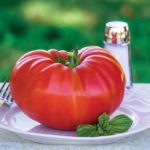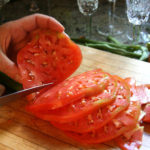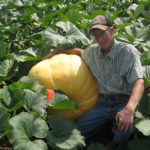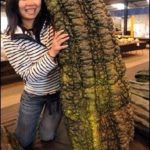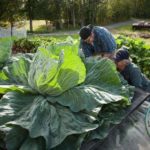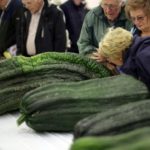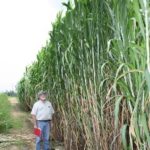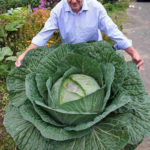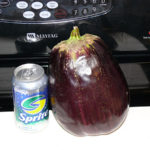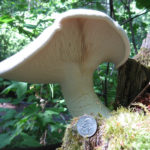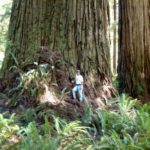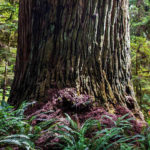The fruits and vegetables you are used to seeing are nothing compared to what can be grown… and has been.
–
Table of Contents:
- How to Grow Giant Crops & Towering Trees
- Detailed Description
- Compost-bin Recipes
- Compost Tea
- Fire-safety Spacing on Slopes
- Compatible Root Systems
- Fish Carcasses & Related Material Added to Root-ball Soil Areas
- The Celestine Technique
- So how big do the crops and their fruits in Inisfree actually get?
–
How to Grow Giant Crops & Towering Trees:
Ever seen those pictures of crops that seem way too big to be anything but a fun Photoshop? Some of them are very real; there are prize-winning pumpkins, for example, which have weighed in heavier than a car. I’ve traveled out to farms and other growing sites around the world to confirm, and now I am ramping up to grow my own.
There is a science to growing crops and other plants so healthy that they tend to become much larger than anything we see in the supermarkets, and it doesn’t involve any bad chemicals or gene manipulation at all. It’s actually simpler than it sounds; you just place the seeds in their ideal environment… and wait. This means using fertile soil and compost tea or fish instead of traditional modern fertilizer, and can be done without any soil, fertilizer, or even sunlight; hydroponically, aeroponically, and aquaponically.
Do you have a good spot for a tree much taller than your house or office building? Do you just want to show off something incredible to guests and the farmers’ markets? I’ll talk you through what it takes to grow the stuff of legends. “Go big or go home.”
–
Detailed Description:
To grow crops larger than the norm (what you see in grocery stores and farm pictures), you can start with the following guidelines:
- Check your soil down to bedrock where possible, ensuring there are no layers of clay or other matter that will stop the spread of a natural root system.
- Space your individual plants far enough apart to allow for maximum root structures to grow.
- Tease them by only watering every other day, or every few days, which causes their roots to grow much deeper in search of more water, which in turn allows them to grow much taller, and produce more fruit.
- Prevent any competition in the garden; keep aggressive plants isolated, and all pests out, allowing all of the energy produced by each plant to be used for its growth, rather than its defense or repair.
- Use natural means of maintaining fertile soil, if growing outdoors in the traditional method, such as plants which deposit the exact nutrients back into the soil that your next or nearby set of plants need.
- Supplement the soil with fish carcasses and related material proven to be beneficial and accelerating to what you have planted.
- Use hoop-houses and other coverings to keep your plants at the right temperature, screened from pests (such as birds, rabbits, and some bugs), and shielded from inclement weather (such as wind and hail).
- 1% biochar alone –as a soil additive— gives 90% larger plants; essentially ~2x bigger than what you are probably used to seeing and buying. This is added to the soil, not the topsoil or compost, but can be sprinkled around, as well.
- nonstop sunlight (or via special LEDs), and zero pests (possible in controlled environments, such as shipping-container farms now on the market), and you get 5x larger or more
–and since the height of Inisfree’s perimeter wall and central mountain, paired with how low the Sun stays in the Antarctic sky during its Summer (when the northern hemisphere is having its Winter), results in a shadow over our main farmland for half of each Summer day (in 2 6-hour intervals), and since the Sun stays below that horizon for the rest of the year, the majority of growth beyond what Outlanders think is normal… for our surface crops (those not in our silo-annexes)… comes from us always providing the best combinations of all the other giant-growth-assisting methods mentioned on this webpage.
(See our Maps “Sunlight and Shadow” album for further details.)
-
charcoal produced from plant matter and stored in the soil as a means of removing carbon dioxide from the atmosphere.
* Biochar can stay in soil for THOUSANDS of years –proven when we discovered it for the first time in Amazon. (That exact soil; the most fertile and time-tested from the Amazon, is called Terra Preta, by the way, and is available on the market.)
–
Compost-bin Recipes:
If you have a grill, trash can, washing machine cylinder, or other container meant for making and keeping compost, make sure you are adding the best mixture of compost elements, turning it regularly, and checking its core temperature to ensure it has achieved its ideal state. The French make compost almost entirely out of fallen leaves, in many cases, but there are other ways to create this soil-enriching mixture. Some of the best compost recipes are covered in full detail in the videos at the bottom of this webpage.
–
Compost Tea:
In addition to regular, dirt-like compost, a liquid form is also effective. This is called ‘compost tea’, as it looks like the brown watery drink you find in any coffee or tea shop. Pouring it within the topsoil rings around your plants covers both their water and compost needs, and is a great way to keep them healthy, and even grow them very large, in cases where burying fish in their soil is not possible or recommended. Details are in the videos below.
–
Fire-safety Spacing on Slopes:
The steeper your yard or farm is, the more spacing experts recommend between plants, especially tall trees. This allows for enough dispersion to lessen the likelihood of the spread of wildfires; trees far apart are often more out of reach of both the heat and ‘leaping’ flames from plants which have caught fire. Embers and falling limbs can still present a threat, but correct spacing still makes a huge difference, and can save you untold millions of dollars in property damage, not to mention years or even decades of growth for the longer-lived species.
–
Compatible Root Systems:
Some plants are more aggressive than others, some take and replace different nutrients in the soil, and some can pass on their flavor to the more absorbent ones. An example is pepper plants; peppers and other spicy flora can transfer some of their spiciness to things such as melons, making them taste awful. It is a good idea to keep such incompatible species isolated from one another, preventing that type of contamination and souring, as well as any unwanted cross-pollination (which creates new strains/variants/sub-species). Multiple species which require a lot of water, such as watermelons and pecan trees, should be kept far apart, too; otherwise they will leave each other thirsty, stunting their growth.
–
Fish Carcasses & Related Material Added to Root-ball Soil Areas:
This is a proven technique to rapidly increase growth; the plants love consuming and converting things such as whole fish buried with their root systems, and added to their topsoil rings. As with spicy plants causing melons to taste spicy, adding things such as fish to the soil around some plants can make them taste foul, so only do this with ones such as trees, shrubs, and cabbage or lettuce for competitions, not anywhere near ones such as berries, melons, or squash.
–
The Celestine Technique:
In the book called The Celestine Prophecy, there is a theory presented which involves actually focusing on and caring about the crops and other plants being grown. It considers the possibility that plants, just like animals, respond on some level, even if just a little bit, to the ‘atmosphere’ and attitudes of the other lifeforms around them. Like with people, when they feel trapped around incompatible beings who hate or ignore them, they tend not to grow so well, or be so relaxed, outgoing, and productive. If that holds true for flowers, trees, and other plants, it can mean a very different quantity and quality per harvest. This is something worth testing, new and alien though it may seem to the traditional farmers and horticulturists.
* ICVs are designed to provide the perfect kinds of love each being they encounter needs, and their sensory organs are designed to be able to easily notice and monitor the slightest changes in things, such as whether or not caring about what you are farming is actually making a positive difference on the growth, flavor, and longevity of those plants. This means the Inisfreean girls are not only naturally perfect lovers, but perfect farmers and scientists. The results speak for themselves.
–
So how big do the crops and their fruits in Inisfree actually get?
Our produce grows naturally to much larger sizes than in the Outlands (places beyond Inisfree) because we keep our crops’ environments ideal. Here are some specific crop and size examples:
- blueberries the size of golf balls
- grapes the size of tennis balls
- strawberries the size of baseballs
- bell peppers, grapefruits, and tomatoes the size of basketballs
- Portobello mushrooms the size of pizza/platter (the cap) on a stool (the stem)
- green beans the size of squash and zucchini
- bananas the size of baseball bats
- carrots and squash the size of SCUBA tanks
- potatoes the size of pumpkins and beanbag chairs
- broccoli heads the size of big flower vase presentations
- cabbage and lettuce the size of beach balls
- pumpkins and watermelons the size of cars and weather balloons
- asparagus and Brussels sprouts stalks as tall as people
- bamboo as tall as telephone poles
–
* Credit to great horticulturalists & master gardeners such as Professor Toby Day for introducing me to all the details of this path!
–
–
playlist


